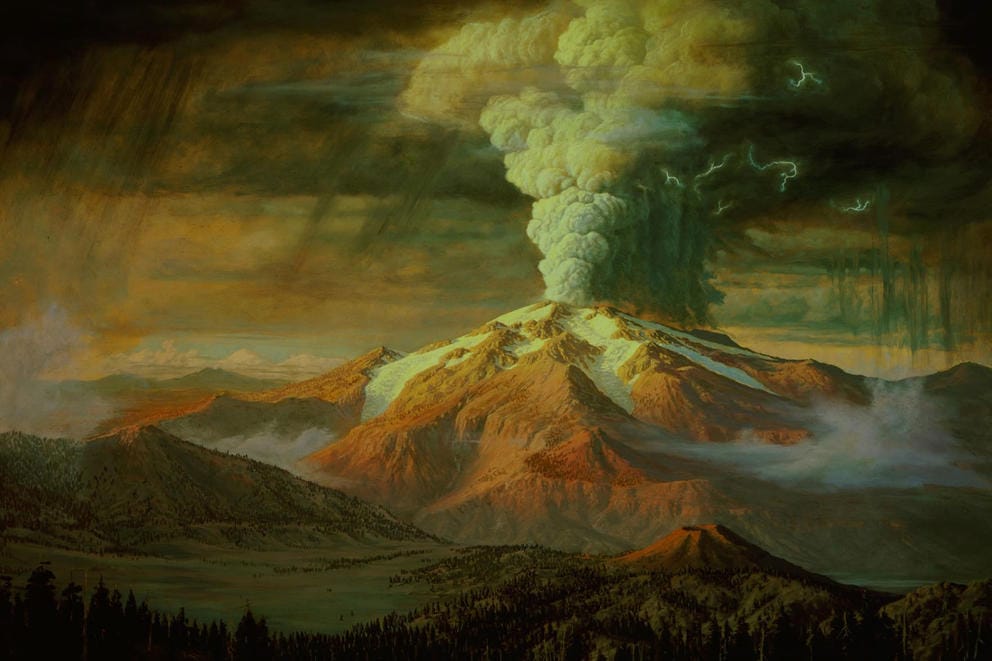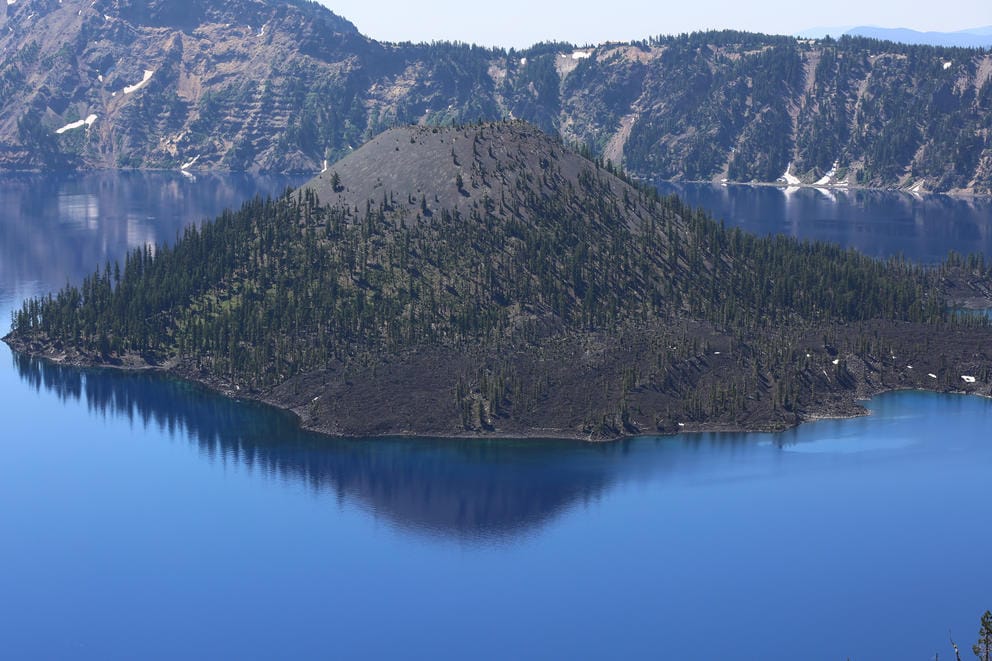This is one of the most spectacular gems of the Cascades — an extraordinary blue mountain lake at an altitude of 6,000 feet that is also the deepest lake in North America.
Many natural wonders are the result of natural disasters. Standing on the rim of Crater Lake, it’s hard to picture the massive cataclysm that made it. Some 7,800 years — more than 3,000 years before the Egyptian pyramids were built — ago a super-volcano, Mount Mazama, blew its top. It was the greatest Cascades explosion in the past 600,000 years.
Today we witness the beautiful aftermath and consider its impact on the Klamath people and others who saw it happen.
Over the millennia, volcanic hotspots and cones have spewed lava and ash from this spot. Volcanic violence and glacier action carved the area. Smaller volcanoes came and went. The eruptive activity coalesced into what we call Mount Mazama. Thousands of years ago it stood some 12,000 feet high. Then one autumn day eight millennia ago it exploded on an epic scale.
According to the U.S. Geological Survey, the blast took off the top of the mountain and the cone collapsed inward, creating a huge caldera five miles across. Ash and debris covered much of Oregon, Washington, Idaho, and parts of California, Nevada, Montana, Utah, Wyoming, British Columbia and Alberta. Some traces of Mazama ash have even been found as far away as Greenland.
The eruption is said to have been 40 to 50 times as powerful as that of Mount St. Helens in 1980. If you’ve seen film or TV footage from that eruption, you know how devastating the ash, floods, pyroclastic flows and blast zone could be. So too with Mazama. Its eruption lasted many days, burned forests, turned day into night and choked the air. It buried some areas in 14 feet of ash.
The cataclysm left an indelible mark where its debris fell, creating in many places a timeline in the soil, a distinct layer of before and after.

A cross section showing the aftermath of the Mazama eruption. Library of Congress
The Northwest was already long occupied by Indigenous people. Evidence is found below the ash layer that has helped push dates of human occupation back to the Ice Age. At the Paisley Caves in Oregon, evidence shows people were sheltering more than 14,000 years ago. There’s evidence that Mazama ash may have snuffed out ancient hearths. Stone tools and flakes found in Redmond below the distinct Mazama ash layer have been dated back about 14,000 years. Evidence of Indigenous occupation above the ash layer is nearly as old as the eruption.
In Alberta, researchers say that for days a “dry snow” of fallout buried prairies in ash. Game, including herds of buffalo, were displaced along with those who hunted them. Centuries passed before people returned. Eruptions of the Mazama scale are rare but have the potential to impact climate, disrupt ecosystems and devastate communities.
Those who lived within view of the mountain recorded what occurred in oral stories and traditions that scientists say track closely with the geologic record. The Klamath people of southern Oregon remembered smaller eruptions over time before the mountain finally blew and ejected massive hot rocks and pumice “as big as hills and burning ash falling like rain.” People were said to have retreated into water for protection. They remembered that the mountain fell in on itself and eventually rain and snow filled the deep hole left behind.

A rendering of the eruption of Mount Mazama. The National Parks Service.
Some said that the disaster was punishment for bad human behavior. Crater Lake “came from a battle between spirits … and when the people saw what happened there, they had to run into the water to keep from being burned up,” a Klamath elder has recounted. “They were being punished for forgetting the right way to live. I heard this story from a lot of the old people when I was a kid.”
Crater Lake became a sacred place for many, a place for supernatural beings, shamans and vision-seekers. The lake’s existence was kept secret from the first white settlers. It continues to have sacred significance for the Klamath people today whose ancestral knowledge has been passed down for hundreds of generations.
One historian has written, “As the ash clouds settled and the rumbling ceased, the caldera became a place of pronounced historical and moral significance to the peoples living in all directions.”

Wizard Island in Crater Lake. A cinder cone that developed in the remains of Mount Mazama after the eruption. Michael McClinton
For its extraordinary blue waters and its uniqueness, Crater Lake was designated a National Park in 1902 — the fifth one after Yellowstone, Sequoia, Yosemite and Rainier.
Crater Lake is not a finished product. Geologists say it could erupt again someday. On crystal-clear nights, the stars above reflect in its still waters, a mirror of the galaxy set in high-altitude silence.
One can reflect on the miracle of nature and its power to transform the catastrophic into the sublime. And ponder how lucky we are to get to witness this part of Mazama’s story.



